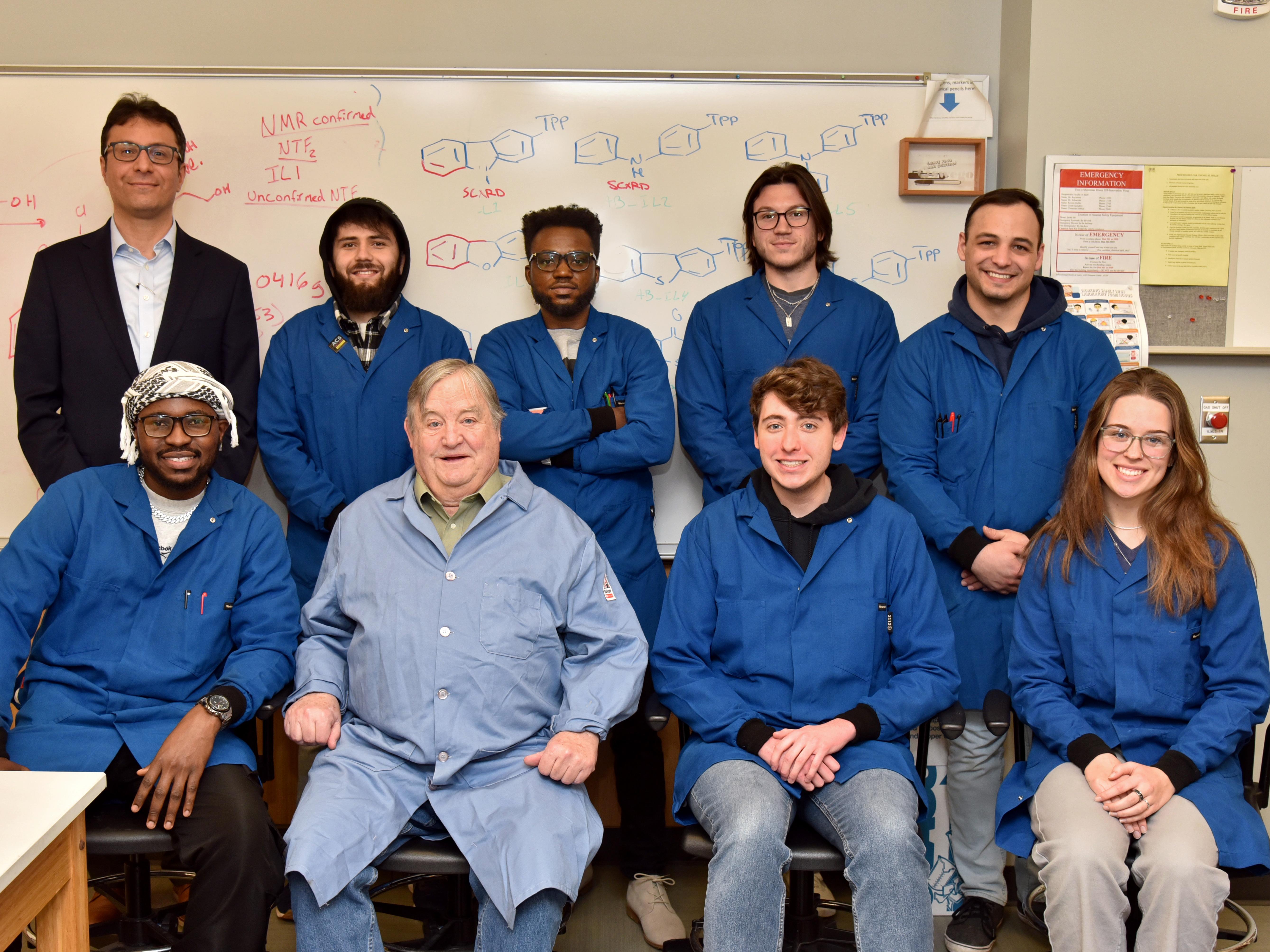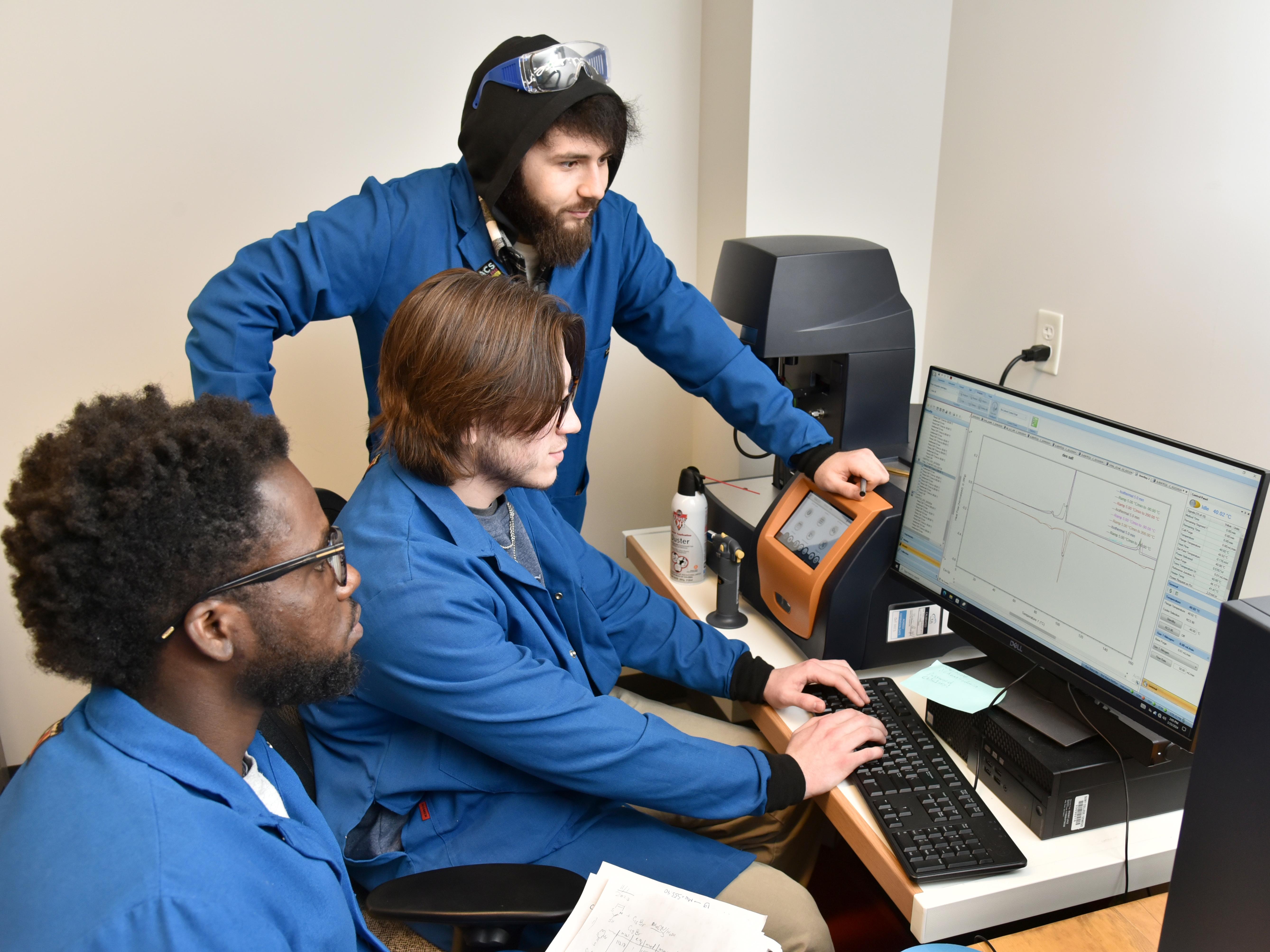In an effort led by Arsalan Mirjafari, the SUNY Oswego's Dr. Richard S. Shineman Professor of Chemistry, a faculty-student team are trying to unlock a better way to maintain vaccines (including COVID-19 vaccines) against other current or future viruses. Here student researchers (from left) Clinton Adu, Blake Britton and Muhammad Musozoda examine data.
A SUNY Oswego faculty-led project in a Shineman Center chemistry laboratory seeks to unlock a better way to maintain vaccines (including COVID-19 vaccines) against other current or future viruses.
Arsalan Mirjafari, the university’s Dr. Richard S. Shineman Professor of Chemistry, leads the effort thanks to a pair of grants from the National Institutes of Health (NIH).
“Vaccines are one of the most important innovations of our time,” Mirjafari said. “The response to the COVID epidemic showed us that developing effective vaccines can save millions of lives.”
But the logistics for effective and secure vaccines remain challenging, especially since these require subzero temperatures to remain viable.
“These vaccines have to be kept cold from production through administration,” a process referred to as the “cold chain,” Mirjafari explained. “This requirement provided challenges for many countries, especially poor and middle-income ones. And we saw this challenge in rural and poorer areas of the U.S. that didn’t have adequate infrastructure.”
“We are doing research using some sugars with ionic liquids that we synthesize to be able to preserve the vaccine at room temperature to eliminate the cold chain, as vaccines currently need to be preserved in cold temperatures,” said student researcher Muhammad Musozoda, who is now a chemistry graduate student who started working on the project as an Oswego undergraduate chemistry major. “We’re also trying to make the end result affordable.”
“Our central aim is to produce thermostable vaccines, including COVID vaccines, to provide equitable access to these vaccines,” Mirjafari said. “Our focus is on the entire world but especially low- and middle-income countries.”
The research objective is to rationally develop ionic liquid formulations that can preserve vaccines at room temperature for up to two years.
“Imagine how much simpler it would be to store vaccines on a shelf, put them in a backpack for a clinic or send along regular transportation supply chains,” Mirjafari said. “It would relieve a huge burden and could democratize the distribution of vaccines worldwide.”
But the project has implications beyond COVID vaccines, he added.
“The other goal is to prepare the world for future epidemics and pandemics – in addition to current ones like yellow fever and Zika,” Mirjafari said.
NIH support
The original support comes from an NIH R21 grant, which is for “high-risk, high-value projects,” Mirjafari noted. Titled “Novel organic-ion-based technology for long-term virus preservation at ambient temperature,” this support of more than $300,000 transferred from his previous institution of Florida Gulf Coast University, where he is still collaborating with researcher Scott Michael.
The subsequent NIH R15 grant titled “Vaccine Thermostability with Natural Deep Eutectic Solvents,” continues the research and collaboration between the two institutions with a three-year grant of nearly $460,000.
“Our job is to synthesize these chemicals to ensure they are very secure for biological applications,” Mirijafari said. “Our research is located at the interface of biology and chemistry. We also do some computational studies to make sure they interact safely.”
Mirjafari will then ship these chemicals to his collaborator in Florida to test on viral models to ensure they are effective and non-toxic. The two colleges interact on as many iterations as possible to ensure a successful outcome.
“Nobody has done this before,” Mirjafari said. “There is a huge need for this.”
Recruiting a variety of students from Oswego’s highly regarded STEM programs has proven fruitful, with four research papers published already.
“They are motivated, they are hard-working and I’ve had great experiences with them,” Mirjafari said. “I’m very fortunate. Every day I come to work, I know I made the right decision.”
Student experiences
Musozoda would agree. “Ever since I’ve been doing research with Dr. Mirjafari in a lab, I’ve been able to start thinking like a scientist,” Musozoda said. “He’s been treating me as a co-worker, not a student.”
In addition, Musozoda has gained a lot working on multiple projects since being a sophomore, including publishing a paper in Chemical Communications, a Royal Society of Chemistry journal, about using synthetics as ionic liquids, co-crystalizing alkyl halides. “It was a proof of concept that had never been done before,” Musozoda noted.
Zachary Matott, a biochemistry major working on the project, also has published recently in Chemical Communications on the applications of ionic liquids for gene therapy.
“I think the biggest thing I’m getting out of this is laboratory skills,” Matott said. “I learned a lot of things in this lab over the summer. Working with Dr. Mirjafari lets me learn how to do things in the field. Also learning about writing research papers and ways to revise and improve them is huge to me.”
“At the end of the day, our goal is to make the world a better place,” Mirjafari said. “And students can get trained to get into and succeed at top graduate schools.”

The faculty-student team researching ways to better preserve vaccines includes: back row from left, Arsalan Mirjafari (Dr. Richard S. Shineman Endowed Chair and Professor in Chemistry), Muhanmmad Musozoda (master’s in chemistry student), Clinton Adu (master’s in chemistry student), Blake Britton (undergraduate chemistry major) and Chris Butch (master’s in chemistry student); front row from left: Bobby Yeboah (master’s in chemistry student), Mike Knopp (research associate), Zachary Metott (undergraduate biochemistry major) and Molly Roes (undergraduate biology major).




